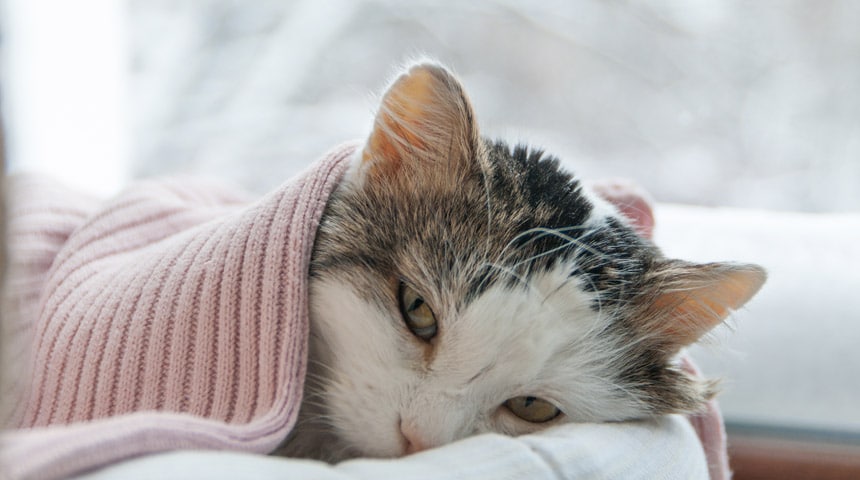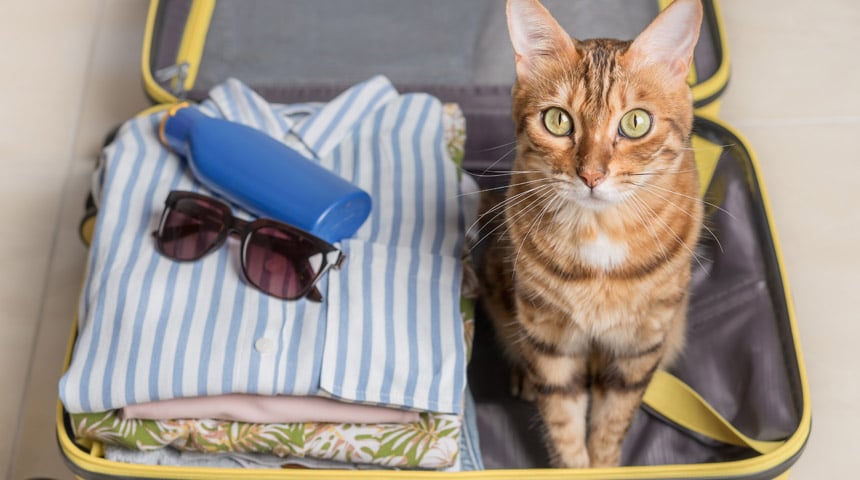What is a senior cat?
Like us, cats go through different life stages: kitten, young adult, mature adult, senior, and geriatric. A cat is generally considered a senior when they reach the age of 8-9 years old. Evidently, as they age their needs become very different and it is helpful to understand the physical and emotional changes that happen as your cat ages.
Common age-related changes include :
- Changes in behaviour and sleeping patterns
- Increased ‘talking’ or meowing
- Pain related to movement (jumping, using stairs, in/out of high-sided litter box)
- Changes in sight and hearing
- Decreased sense of smell and taste
- Weight loss and loose skin
- Brittle nails or nails that need to be trimmed more often
- Decrease ability to absorb nutrients and increased need for protein
The lifespan of cats is five times shorter than the lifespan of a human, so cats age more quickly than people. An 11-year-old cat is about 60 in human years, but a 16-year-old cat is already 80 in human years. We get a checkup once a year; an equal number of checkups for a healthy senior cat would be every 10-11 weeks! Because much can change in a short time, bringing your senior cat for regular checkups is very important.
My senior cat checkups
Cats are masters of hiding signs of disease and pain, and may appear healthy even if they are sick or hurting. Being a responsible caregiver includes bringing your cat in for regular checkups. Cats 10 and over should have checkups every 6 months. Cats with ongoing health issues may need check-ups more often, depending on their illnesses. Your veterinarian relies on the information you provide about your cat’s daily lifestyle to identify signs of disease, pain, or behaviour changes.
Annual blood and urine tests can help discover problems early on and monitor your cat’s health. Your veterinarian will compare new bloodwork results with previous testing and examine any changes. Check ups help identify disease or age-related health conditions before they are painful or cost more to manage.
Is my old cat in pain?
Although cats are masters of disguise and pain can be hard to notice, your veterinarian is trained to recognize subtle signs of pain. Feline arthritis, or degenerative joint disease (DJD), is very common in cats. Studies show that as many as 92% of cats have DJD. Any change in your cat’s normal behaviour or routine, such as urinating or passing stool outside of the litter box, not being able to jump onto his favourite spot anymore, stiffness when moving around, decreased grooming and so on, can be a sign of pain. You can help your senior cat by providing steps or ramps for easy access to favourite spaces, as well as night lights to help them see better in the dark, litter boxes with low entry, elevated food bowls, etc. Think about items for senior cats in a more accessible manner!
In addition to adapting your house for a senior pet with mobility issues, there are other options to help manage their pain. There are 3 common methods used to help senior cats with joint pain. Talk to your veterinarian to determine which course of action is best suited for your pet!
Three common methods to help senior cats with joint pain :
- Veterinary diets specific for mobility and joint support
- Supplements, such as Glucosamine chews or Omega-3 oil to add to their everyday diet
- Monthly injections with specific medication that directly targets pain in cats suffering from arthritis.
What about nutrition & weight management
Senior cats are at risk of becoming underweight due to a decreasing sense of taste or smell, which can cause a lack of interest in eating. On the other hand, overweight cats are more likely to develop diabetes, arthritis (DJD), heart disease, and lower urinary tract disease, which is why choosing the right diet for your furry friend is important.
For a healthy senior cat, there is a variety of senior diets to choose from. These diets are specifically formulated for your older pet. Senior foods generally have increased antioxidants, easily digestible ingredients, adapted amount of calories to reflect the activity levels of your pet, increased amount of proteins, and additional healthy fats such as Omega-3. However, if your pet has known medical conditions, there are special diets conceived to help manage them, such as early consult renal support diets, hyperthyroidism diets, diabetic diets, etc. Ask your veterinarian for more information on the diet that is best suited for your furry friend.
If your cat is having trouble eating, you can try offering a different texture of food, strong-smelling food, warmed or chilled canned food, or fresh food that hasn’t sat out too long and offered a few times throughout the day. Place food where your cat spends the most time and in a location where your cat can eat quietly and calmly. Senior cats may prefer wide and low-sided food and water bowls that don’t touch their whiskers. Providing elevated bowls can help those that may be in pain from bending down to eat. Hydration is very important for senior cats, so consider providing multiple drinking stations, and speak to your veterinarian about food or supplements that can increase water intake.
Managing diseases & conditions
As your pet ages, it is common for them to develop illness or conditions that require veterinary attention. The most common age-related illness in cats is Chronic Kidney Disease (CKD), which is a gradual loss of kidney function over time.
What is CKD and why is it troublesome?
Kidneys are the organs that help filter and remove waste products out of the blood through the urine. Moreover, they maintain a healthy balance of water, salts and minerals in your cat's body. A cat with CKD has kidneys that are not functioning correctly. Therefore, waste products accumulate in their bloodstream and their urine becomes very diluted (i.e., watery urine), causing them to suffer from symptoms of this illness. Chronic kidney disease happens gradually and, if left unmanaged, can be deadly for cats. It is difficult to visually diagnose CKD as they do not show any signs of illness until their kidneys have already lost two thirds of their functional ability. At that point, the following signs are often observed:
- Weight loss and thin body condition
- Increased thirst and urinating more
- Decreased appetite
- Lethargy
Annual blood tests are strongly recommended for older cats to help catch CKD in the early stages and slow down its progression. Many cats can have a good quality of life and live a long life with CKD if it is properly managed.
Some other common conditions in older cats are arthritis (DJD), thyroid disease (i.e.: hyperthyroidism), high blood pressure, diabetes, dental disease, gastrointestinal disease, cognitive dysfunction syndrome (affecting memory and awareness), and cancer. Typical signs to look out for include, but are not limited to:
- Drinking more or less, and/or producing larger amounts of urine
- Nausea, vomiting, or constipation
- Weight or muscle loss
- Changes in eating pattern
- Decreased appetite
- Finding food outside of the food bowl
- Difficulty eating/chewing food
- Increased appetite combined with weight loss
- Poor fur/coat and decreased grooming
- Changes in behaviour;
- Hyperactivity (unusual activity)
- Anxiety
- Tiredness
- Not using the litter box or urinating/passing stool outside the litter box
- Changes to sleeping patterns and resting locations
- Avoiding contact with others/hiding a lot
- Abnormal swelling or skin masses (unusual lumps or growths)
- Difficulty breathing, urinating or passing stools
We understand that it is hard to see our beloved pet's age and that it can be stressful for you and your cat to manage an illness. However, we urge you to voice your concerns, ideas, and ability to follow through with recommendations to your veterinarian so that together you can create a plan to minimize pain and stress for you and your cat. Continuing checkups remains the best way to monitor your cat’s health, pain and quality of life status.








